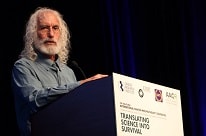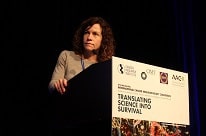
Much of this conference has focused on using immunotherapy to treat cancer. Today, we heard from several investigators who are working on the other end of the equation: developing ways to prevent cancer. This includes what many consider to be the holy grail of medicine: a preventive cancer vaccine.
Currently, the only such preventive cancer vaccines are those that immunize people against certain viruses that cause cancer; by preventing the viral infection, you also prevent the associated cancer. Vaccines to prevent non-virally caused cancers are much harder to develop, since cancer cells resemble our own cells in many ways and therefore are not always recognized by the immune system as dangerous.
While cancer vaccines have great medical appeal, it’s fair to say that they have gotten something of a bad name in recent years. That’s because the cancer vaccines developed to date have so far not achieved their promise; several large clinical trials of these agents failed to show a survival advantage to patients. But there is an extremely important caveat. These were therapeutic cancer vaccines, administered in the hope of treating a cancer that already exists. Researchers increasingly believe that vaccination makes more sense—and will be more effective—when a patient has no or minimal disease. As with vaccination for infectious disease, the best time to do it is early.
First to explore the topic of prevention was Jolanda deVries, PhD, of the Centre for Molecular Life Sciences, The Netherlands, who has been exploring a cancer vaccine for people with Lynch syndrome, who are at great risk of developing colorectal cancer (CRC). Lynch syndrome is caused by an inherited genetic defect in the body’s DNA repair machinery that leads to the accumulation of DNA mutations in cells. These mutations eventually cause colorectal cancer in approximately 80% of patients. About 5% of CRC patients have Lynch syndrome.
The particular vaccine approach that deVries is using involves dendritic cells (DC), which are antigen-presenting cells that play an important role in starting immune responses. DC vaccines have been used to treat several different types of cancer, including melanoma and prostate cancer. DeVries took as a starting point the observation that melanoma patients who had T cells in their tumor before treatment with a DC vaccine had better survival outcomes. This suggested to her that other cancer types with a strong T cell presence in tumors would be good candidates for vaccination, and Lynch syndrome-associated colorectal cancer falls into that category.
Also like melanoma, Lynch syndrome-associated CRC can be considered an immunologically “hot” tumor, in the sense that it contains many genetic mutations, increasing the likelihood that it will be recognized as dangerous by the immune system.
DeVries was able to show that a DC vaccine made from commonly mutated proteins in CRC tumors was safe to administer, and also led to a documented rise in antigen-specific T cells in the blood of these patients. She is now conducting a clinical trial of the vaccine in Lynch syndrome patients who do not yet have cancer (but who are very likely to develop it).
 Next up was Robert Vonderheide, MD, DPhil, a cancer immunologist at the University of Pennsylvania, and also a member of CRI’s Scientific Advisory Council, who reminded the audience that it was Ben Franklin, Penn’s founder, who cautioned, “an ounce of prevention is worth a pound of cure.” Taking that adage to heart, Vonderheide set himself the challenge of developing what he calls a “polio vaccine” for cancer—a widely effective means to prevent cancer in at-risk populations.
Next up was Robert Vonderheide, MD, DPhil, a cancer immunologist at the University of Pennsylvania, and also a member of CRI’s Scientific Advisory Council, who reminded the audience that it was Ben Franklin, Penn’s founder, who cautioned, “an ounce of prevention is worth a pound of cure.” Taking that adage to heart, Vonderheide set himself the challenge of developing what he calls a “polio vaccine” for cancer—a widely effective means to prevent cancer in at-risk populations.
To develop such a vaccine, he knew he would need a “universal tumor antigen,” an immunogenic protein that could be found in many if not all cancers. He found his putative universal tumor antigen in a molecule called telomerase reverse transcriptase (TERT), which is produced by the vast majority of human cancers, but which is not typically found in normal cells. Indeed, this enzyme is believed to be what allows cancer cells to become “immortal”—able to divide indefinitely—a property that normal cells lack.
Vonderheide has started a clinical trial of a TERT-based preventive cancer vaccine for patients with BRCA1/2 gene mutations. People with these mutations have much higher rates of several types of cancer, including breast, ovarian, and pancreatic cancer, and often develop these cancers at much younger ages than those without the mutations. The vaccine is a DNA-based vaccine that includes a non-functional version of TERT as well as the gene for IL-12, a potent immune stimulator. This will be a first-in-human trial of the vaccine. Patients will be enrolled after surgery and any adjuvant therapy. If the trial goes well, the next goal would be to evaluate the vaccine in patients prior to surgery. Having an effective vaccine for this high-risk population would be a major therapeutic advance, since for many of these individuals the question is not will they develop cancer, but when.
Another patient population that would be well served by a safe and effective immunotherapy to prevent cancer is pancreatic cancer patients who have had surgery to remove their primary tumor but who are at high risk of having a recurrence. Pancreatic cancer has been branded an immunologically “cold” tumor, but according to Rienk Offringa, PhD, of German Cancer Research Center (DKFZ), this is an unfair characterization. In the hospital where he works, he has seen first hand that roughly 80% of resected pancreatic tumors do have T cells within them, implying that there are available tumor antigens that T cells can target. Taking a cue from this observation, Offringa is developing an adoptive cell therapy approach to pancreatic cancer similar to the one that has been used successfully in melanoma (see Day 1 blog). The approach involves removing T cells from the tumor, growing them in the lab, and then re-infusing them into the patient. The time to do the treatment, he suggests, is at the first sign of a recurrence, as measured by a blood marker of pancreatic cancer called CA19-9.
The Right Tools for the Job
The other big theme of today was the design and use of effective pre-clinical models for studying immunotherapies. Before new immunotherapies can make it to the clinic and to FDA approval, they need to be proven effective in pre-clinical testing. That requires having experimental systems that accurately mimic the disease condition in humans.
 As Phil Greenberg, MD, an immunologist at the Fred Hutchinson Cancer Center and a member of CRI’s Scientific Advisory Council, noted in his introduction to the session, the field of cancer research is especially in need of good pre-clinical research models. A hard-learned lesson in the field is that drugs that look promising in a petri dish, or even in a mouse with a transplanted tumor, often don’t work the same in a person. The development of mouse models of cancer that faithfully recapitulate the human disease was a major advance in the field, one that is leading to better understanding of how to treat cancer with immunotherapy.
As Phil Greenberg, MD, an immunologist at the Fred Hutchinson Cancer Center and a member of CRI’s Scientific Advisory Council, noted in his introduction to the session, the field of cancer research is especially in need of good pre-clinical research models. A hard-learned lesson in the field is that drugs that look promising in a petri dish, or even in a mouse with a transplanted tumor, often don’t work the same in a person. The development of mouse models of cancer that faithfully recapitulate the human disease was a major advance in the field, one that is leading to better understanding of how to treat cancer with immunotherapy.
 On this front, Ingunn Stromnes, PhD, a CRI postdoctoral fellow at the University of Washington, is using a mouse model of pancreatic cancer to study immunotherapy with genetically engineered T cells. Her approach involves introducing a mutation into a T cell receptor (TCR) that recognizes an antigen called mesothelin found on pancreatic cancer cells. The mutation enhances the TCR’s binding to this antigen, making it a more effective weapon. What Stromnes finds is that when these T cells are infused into mice with pancreatic cancer, they traffic to the tumor and begin to proliferate—all good things—but then they begin to die—not a good thing. Stromnes is not entirely sure why the cells are dying, but it may be related to the extreme immunosuppressive environment of pancreatic cancer. To partially combat this problem, she experimented with performing multiple, sequential infusions. What she sees in this case is that the newly infused cells also work for a time and then die, but before they do so they are able to double the survival time of the mice.
On this front, Ingunn Stromnes, PhD, a CRI postdoctoral fellow at the University of Washington, is using a mouse model of pancreatic cancer to study immunotherapy with genetically engineered T cells. Her approach involves introducing a mutation into a T cell receptor (TCR) that recognizes an antigen called mesothelin found on pancreatic cancer cells. The mutation enhances the TCR’s binding to this antigen, making it a more effective weapon. What Stromnes finds is that when these T cells are infused into mice with pancreatic cancer, they traffic to the tumor and begin to proliferate—all good things—but then they begin to die—not a good thing. Stromnes is not entirely sure why the cells are dying, but it may be related to the extreme immunosuppressive environment of pancreatic cancer. To partially combat this problem, she experimented with performing multiple, sequential infusions. What she sees in this case is that the newly infused cells also work for a time and then die, but before they do so they are able to double the survival time of the mice.
In this same session, Charles Drake, MD, PhD, of Johns Hopkins and also of CRI’s Scientific Advisory Council, presented some recent work from his lab using a mouse model of castration-resistant prostate cancer. About 1 in 6 men will develop prostate cancer in their lives, and 1 in 6 of those will die from the disease. What kills patients is not the local disease, but the spread to other organs. Prostate cancer is typically treated with radiation and with hormone blockers (called, inelegantly, “castration”). The hormone blockers usually work great for a while, depriving the tumor of the hormones they need to grow, but eventually the tumor develops resistance (hence the label “castration resistant”). Castration-resistant prostate cancer is what kills these men.
Immunotherapy with checkpoint inhibitors so far has not proven to be beneficial to patients with prostate cancer. Why that is the case is not totally understood. Drake has used his mouse model to show two important things that bear on the question. First, he has shown that hormone deprivation in these mice induces inflammation in the tumor, which leads to an influx of T cells. Using checkpoint inhibitors in this context is effective at treating prostate cancer in the mice. Second, when it comes to antibody therapies, “isotype matters.” What this means, as I have suggested in a previous post, is that the back end of the antibody can make a big difference in therapeutic outcome. Drake has found that a CTLA-4 antibody that is specifically designed to be depleting works better in this context than a non-depleting one. These particular depleting antibodies exist for mice but not for humans. Drake said he and his team at Hopkins would be interested in doing a clinical trial in patients if this drug could be made.
There was much more at this conference than I have been able to cover here in these short blog posts, but I hope I have at least given you a flavor for the breadth and depth of promising research that is taking place in this exciting field. It’s by supporting such basic, translational, and clinical work that the Cancer Research Institute and its sister organizations are helping to bring new, effective, and indeed curative treatments to people with cancer.
For more information about cancer immunotherapy, visit www.cancerresearch.org.
